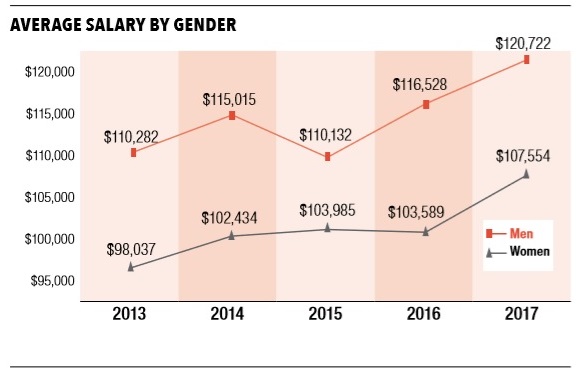
The Gender Pay Gap Remains
TDWI's 2017 salary survey reveals that little has changed in the wage disparity between men and women in BI.
- By Fern Halper
- May 15, 2018
Since joining TDWI about six years ago, I have been following and reporting on our salary survey. The report quantifies and interprets the compensation, roles, responsibilities, skills, and experience of individual BI and IT professionals. It also provides detailed profiles of the 10 most common BI and data warehousing roles, examining age, gender, education, salary and bonus, background, and other characteristics. TDWI has been collecting this data for years and it is a great TDWI member benefit.
I am particularly interested in the gender gap in pay between men and women in BI/IT. Recently, I have been examining the results from TDWI's latest salary survey. Approximately 360 people from the U.S. and Canada responded to the survey, with a female/male ratio of 30/70. Although U.S. salaries are generally higher than those in Canada, overall, the gender gap in BI/IT related fields widened in 2017. Men averaged $120,722 (median income: $116,000) and women averaged $107,554 (median income: $106,000), a margin of $13,168. Similarly, men continued to do better with bonuses, receiving $1,500 more than women.

Source: TDWI, 2017
I decided to drill down into this data a bit further. For the purpose of the analysis that follows, I examined only respondents who work full time. There was no significant difference between men and women for demographic characteristics such as age, length of time in a BI/IT career, and education level. As was the case last year, however, it is a complex picture.
- Roles play a role: In 2017, women were still more likely to be in lower-paying roles such as data analyst/data modeler (median salary $89K) or business requirements analyst (median salary $85K) than men. Things don't improve for women in higher-paying jobs, where most earned less than men in these positions. Even so, on average, women in many roles stated they felt they were fairly compensated despite being paid less than their male counterparts.
- Women earn smaller bonuses than men do. As noted, women in this study received less in bonuses than men. In 2017, the median bonus for women who received a bonus was $8,600. The median bonus for men who received a bonus was $12,000. Additionally, for those who received bonuses, men were more likely to receive individual performance rewards than women (65 percent to 50 percent, a significant difference).
- Women earn less at every education level. Although salaries for both men and women increase with higher educational levels, at any education level men are paid more, on average, than women. In fact, in some instances, women with higher educational levels are paid less than men with lower levels of education.
Overall, women earned 91 percent of what men did last year. Although this is slightly better than last year's gap (at 89 percent), there is still room for improvement, including in the higher-paying jobs where the earnings ratio is sometimes even lower. As I mentioned in my article last year, there are numerous reasons why women may earn less than men in IT/BI-related jobs. First, women may start at lower pay (or in a lower-paying job) than a man with similar experience, perhaps either because of discrimination or because they may not negotiate well for themselves.
Then there is the "motherhood penalty." Studies have shown that employers are less likely to hire mothers (including mothers who never left the workforce) and that mothers typically receive a lower wage than childless women do. (For more, read the 2016 AAUW study, "The Simple Truth about the Gender Pay Gap.") If they take a leave and return to a new job, they may earn less than when they left. Additionally, if they come back to the same workplace but cut back hours, they may not advance as quickly. Whether women are discriminated against for higher-paying jobs, start off at a lower salary base, or take a leave, any future raises are based on their (now) lower rate, which makes it hard to catch up.
My message hasn't changed in a year. We, as women, need to better advocate for ourselves. We need to ask about an individual bonus and what it takes to get it or incorporate it into the company's bonus structure. When accepting a job (even if it is an internal move), we must make use of crowdsourcing sites such as glassdoor.com and payscale.com to gather information about salary (men should do this, too). Sites such as LinkedIn also provide salary estimates for jobs where they have data. Be prepared and know your worth.
About the Author
Fern Halper, Ph.D., is well known in the analytics community, having published hundreds of articles, research reports, speeches, webinars, and more on data mining and information technology over the past 20 years. Halper is also co-author of several “Dummies” books on cloud computing, hybrid cloud, and big data. She is VP and senior research director, advanced analytics at TDWI Research, focusing on predictive analytics, social media analysis, text analytics, cloud computing, and “big data” analytics approaches. She has been a partner at industry analyst firm Hurwitz & Associates and a lead analyst for Bell Labs. Her Ph.D. is from Texas A&M University. You can reach her at [email protected] or LinkedIn at linkedin.com/in/fbhalper.